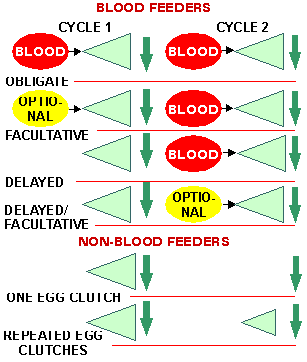Gonotrophic Interactions in Mosquitoes
A blood meal is usually required for the production of each egg clutch in mosquitoes with piercing-type mouthparts. However, in some hematophagous mosquitoes, blood feeding is optional, and not necessary for the maturation of the initial egg clutch.
Still other mosquitoes forego blood feeding until after they have deposited their first egg clutch. And in a few species, females have totally abandoned the blood-feeding habit, though they are equipped with piercing-type mouthparts. When a blood meal is not used the burden of accruing materials for egg production is shifted from adult to larva. The figure illustrates the different types of gonotrophic patterns found in various mosquito species. Our studies are seeking to identify the factors responsible for the occurrence of variation in gonotrophic interaction within and among mosquito species.
|
Summary of the blood-feeding/egg development patterns found in various mosquito species during the first and second egg development cycles. Triangles denote egg maturation and arrows denote oviposition. |
Contact: G. O'Meara
- Back to FMEL Research Areas

